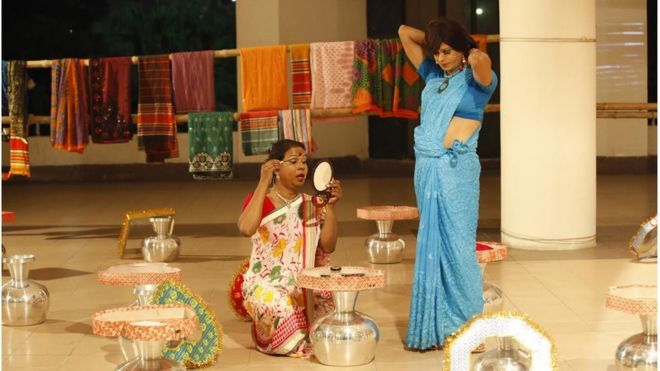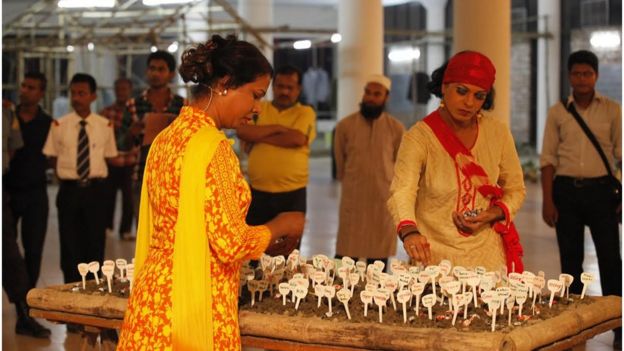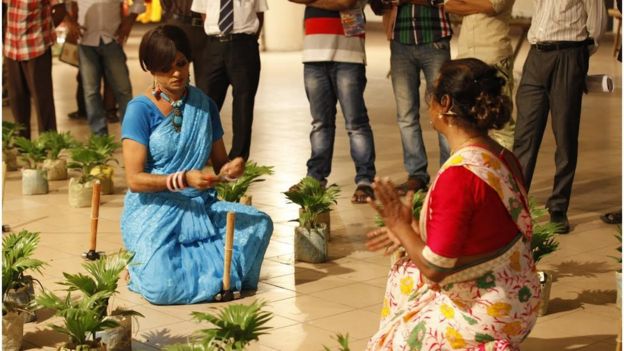 Ananya applies make-up during a performance on the nature of identity where hijras dream of having their own home and being accepted
Ananya applies make-up during a performance on the nature of identity where hijras dream of having their own home and being accepted
Forty-two-year-old Ananya Banik was born a boy in the northern Mymensingh district of Bangladesh. But as she approached adolescence, her identity and sexuality were in turmoil.
Since living openly as a hijra, or transgender person, at the age of 16, she has found several good jobs, learned classical Indian dance, and even performed on national TV to show the life of the hijra community.
But it has been a difficult journey.
"My relatives and neighbours used to ask my mother: Why does your son walk and behave like a female?" says Ananya.
Ananya felt like a girl trapped in a boy's body. She loved to dress up.
"A female soul was dormant in my body and mind," she says.
After an inner struggle, Ananya decided to live openly as a hijra, or transgender person, at the age of 16.
When she went public, her family became desperate to remove her.
"My family wanted to get rid of me because they had to face a lot of unpleasant questions from neighbours and relatives," says Ananya.
Ananya's mother was the only person who supported her but after her father died, her brothers disowned her.
Ancient tradition
Hijras are often rejected by their families despite being part of an ancient South Asian tradition which is mentioned in the Karma Sutra.
The government estimates there are 15,000 hijras in Bangladesh but rights groups say the figure is closer to half a million.

Ananya says she was lucky to be able to stay with her family until the age of 16 as many are exiled from their home at a much younger age.
Unsurprisingly, hijras remain one of the most marginalised groups in Bangladesh despite being officially recognised as a third gender in 2013.
They held their first pride rally last year and continue to campaign for better treatment.
Many hijras live in slum areas and subsist on odd jobs.
They are often turned down for work so many take to the streets and demand money from roadside shopkeepers - using abusive language if any shopkeeper refuses to pay money.
Ananya says it is the only way they can eke out a living.
"Many hijras are forced to collect money from shopkeepers. They don't have any other way to earn money."
'Victims of circumstance'
Unlike other hijras, Ananya learned classical Indian dance and traditional Bengali folk song.
"I had the opportunity to showcase the life of the hijra community for the first time on [a] national television station."
She also worked for a variety of foreign non-governmental organisations but even within this "so called modern and educated setting", she says she struggled to be accepted.
"Many of my colleagues were uncomfortable around me. They wouldn't sit me with me at lunch," she says.
"They wouldn't get into the office lift if I was inside."

There are few hijras who manage to get proper work like Ananya.
Many fall into crime, furthering widening the gulf with the rest of society.
"Hijras are victims of circumstance," says Ananya.
"They are being used by different quarters for personal gains."
But hijras have also been in the news for the positive reasons.
There have been a spate of violent murders in Bangladesh this year, including the killing of five secular bloggers.
In all but one case, the killers fled from the scene even though hundreds of people were in the locality.
But in one case, Labannya, a hijra, became a hero as she pinned down the attackers.
This is the only case where blogger killers have been identified and caught.
After this incident, the government said it was considering hiring hijras to maintain Dhaka's chaotic traffic.
Hijras believe they can contribute to the society if proper support is given.
"I dream of a society where hijras won't be discriminated against," says Ananya.
"I'm a hijra but I'm not a burden to society."



No comments:
Post a Comment